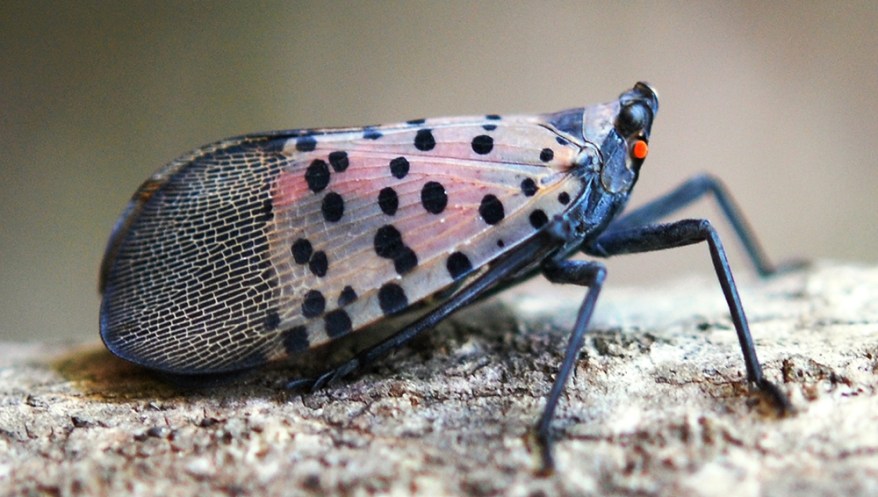Scientists Release First Map of Areas Suitable for Spotted Lanternfly’s Establishment in U.S. and World
go.ncsu.edu/readext?627974
en Español / em Português
El inglés es el idioma de control de esta página. En la medida en que haya algún conflicto entre la traducción al inglés y la traducción, el inglés prevalece.
Al hacer clic en el enlace de traducción se activa un servicio de traducción gratuito para convertir la página al español. Al igual que con cualquier traducción por Internet, la conversión no es sensible al contexto y puede que no traduzca el texto en su significado original. NC State Extension no garantiza la exactitud del texto traducido. Por favor, tenga en cuenta que algunas aplicaciones y/o servicios pueden no funcionar como se espera cuando se traducen.
Português
Inglês é o idioma de controle desta página. Na medida que haja algum conflito entre o texto original em Inglês e a tradução, o Inglês prevalece.
Ao clicar no link de tradução, um serviço gratuito de tradução será ativado para converter a página para o Português. Como em qualquer tradução pela internet, a conversão não é sensivel ao contexto e pode não ocorrer a tradução para o significado orginal. O serviço de Extensão da Carolina do Norte (NC State Extension) não garante a exatidão do texto traduzido. Por favor, observe que algumas funções ou serviços podem não funcionar como esperado após a tradução.
English
English is the controlling language of this page. To the extent there is any conflict between the English text and the translation, English controls.
Clicking on the translation link activates a free translation service to convert the page to Spanish. As with any Internet translation, the conversion is not context-sensitive and may not translate the text to its original meaning. NC State Extension does not guarantee the accuracy of the translated text. Please note that some applications and/or services may not function as expected when translated.
Collapse ▲Kim Kaplan | 10/3/2019 | USDA ARS
A map identifying the areas suitable for establishment of the spotted lanternfly (SLF) in the United States and other countries has been published in the Journal of Economic Entomology by Agricultural Research Service scientists.
The SLF, originally from China, has spread to Korea and Japan, and has been found most recently in the United States in Pennsylvania, New Jersey, Virginia and Delaware. These insects are pests of many agricultural crops including almonds, apples, blueberries, cherries, peaches, grapes and hops as well as hardwoods such as oak, walnut and poplar, among others. USDA and State partners have been working to contain SLF populations since 2014.
There is the potential for far reaching economic damage if the SLF becomes widely established in the United States.
Within the United States, SLF could eventually become established in most of New England and the mid-Atlantic states, the central United States, and Pacific coastal states, explained ecologist Tewodros Wakie with the ARS Temperate Tree Fruit and Vegetable Research Unit in Wapato, Washington, who led the project.
“Earlier attempts to predict the spread of the spotted lanternfly using a less sophisticated model had indicated a potential for the pest to become established in warmer areas such as southeastern Florida and in tropical countries,” Wakie said. “But we made use of a more complex model called MAXENT that depends on a wider number of environmental factors including temperature, elevation and rainfall as well as the current known locations of the species.
MAXENT has proven to be much more accurate at predicting where species are likely to spread compared to 16 other methods on 266 species.

Photo credit: Lawrence Barringer, Pennsylvania Department of Agriculture, Bugwood.org
“There are numerous examples where new populations of species were discovered following MAXENT predictions. Our lab group used MAXENT to predict the potential distribution of oriental fruit moth, and apple maggot, and predictions have been more accurate than anything previously,” said Wakie.
Eleven European countries and large parts of the Northeast United States and the Pacific Northwest were found to be prime habitat for SLF establishment in place of tropical locales with MAXENT.
The most important factor in predicting SLF establishment is the mean temperature of the driest quarter of the year; it cannot be too hot or too cold, about 0 degrees C plus or minus 7 degrees C (a temperature range between 19- and 45-degrees F),Wakie explained.
Another important factor in predicting SLF’s possible range is the presence of the tree of heaven—an invasive plant that also originated from China. Although not the only host plant for SLF, it is a highly important host plant for the insect. Studies are underway to identify additional host plants and to find the right biocontrol system.
Results from this study can be used to guide SLF surveys and prioritize management interventions for this pest, Wakie added.




